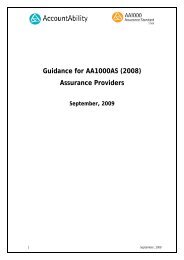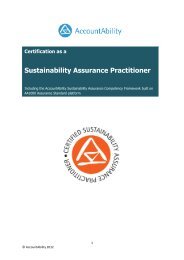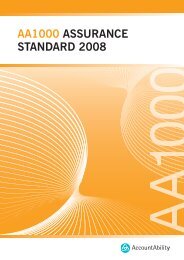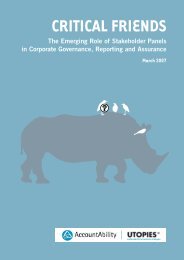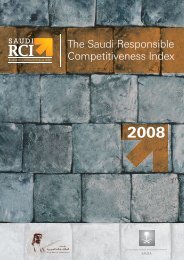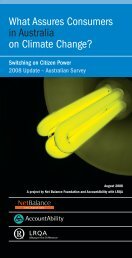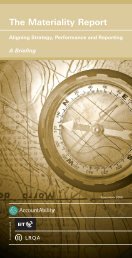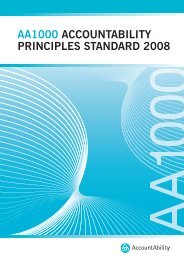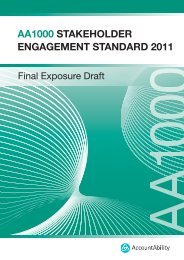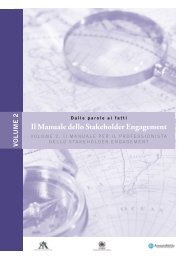The Stakeholder Engagement Manual Volume 2 - AccountAbility
The Stakeholder Engagement Manual Volume 2 - AccountAbility
The Stakeholder Engagement Manual Volume 2 - AccountAbility
Create successful ePaper yourself
Turn your PDF publications into a flip-book with our unique Google optimized e-Paper software.
Organisational<br />
Response<br />
STRATEGIC<br />
EMBEDDED<br />
DEVELOPING<br />
EXPLORATORY<br />
<strong>The</strong> Issue Response Matrix<br />
Higher<br />
Opportunity Green<br />
Zone<br />
STAGE 2<br />
LATENT EMERGING CONSOLIDATING INSTITUTIONALISED<br />
C<br />
B<br />
A<br />
Social Maturity of an Issue<br />
Risky Red Zone<br />
<strong>The</strong> issue response matrix guides you in comparing your company’s way of<br />
dealing with an issue with the maturity of debate about it within society more<br />
broadly. It thereby helps you to identify where you are in a leadership position<br />
and where you are at risk. On the other hand, it also helps you to identify where<br />
you might want to be in relation to an issue under consideration.<br />
Example Application for the Issue Response Matrix: Child Labour in the Supply Chain<br />
<strong>The</strong>re is widespread consensus amongst citizens, consumers, business and governments that children should not be forced to work long<br />
hours in jobs that sacrifi ce their health, safety and education. 141 countries have ratifi ed the ILO Minimum Age Convention and 153 have<br />
ratifi ed the ILO Worst Forms of Child Labour Convention. Most of these countries have legislation on their statute books aimed at ending<br />
child labour and many have programmes to combat child labour often with technical or fi nancial support from the ILO or international<br />
donors. A number of industry associations, NGOs and multi-sector initiatives are also working to address the issue, voluntary guidance for<br />
buyers have been developed, and many businesses are working to improve the management and monitoring systems which help avoid<br />
child labour within their supply chains. It can be considered a consolidated issue.<br />
Yet the ILO estimates that 1 in 6 children is at work instead of at school and three-quarters of these are involved in hazardous work.<br />
Amongst companies whose operations and sourcing networks extend into countries and sectors where child labour is endemic, different<br />
levels of response can be seen.<br />
• <strong>The</strong> business which is still developing its basic policies, where any information it gains about child labour in its supply chain does not<br />
necessarily feed into operational decision making processes, and where there are no performance objectives, would locate its response<br />
at A. Here, the business is vulnerable to advocacy and brand damage, unprepared for potential regulation, and other businesses<br />
leading on the issue may shy away from collaborating with it.<br />
• A business which has systematic management and monitoring processes, policies, targets and ongoing engagement initiatives with<br />
suppliers in place to address and minimise child-labour in its own supply chain would locate its issue response at B and can consider<br />
itself to be in-step with societal development.<br />
• A business which has developed sophisticated organisational policies and management systems on the issue, has assigned top-level<br />
responsibility for avoiding child-labour, and is engaged with a wider range of stakeholders such as industry bodies, governments, NGOs<br />
and the ILO in initiatives to solve the associated challenges, could locate its response at C. This strategic approach might give this<br />
company the opportunity to profi le itself as a particularly responsible business in the marketplace and with regulators.<br />
THE PRACTITIONER'S HANDBOOK ON STAKEHOLDER ENGAGEMENT | 53



